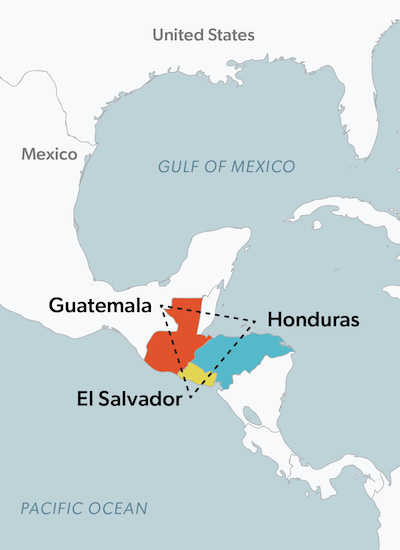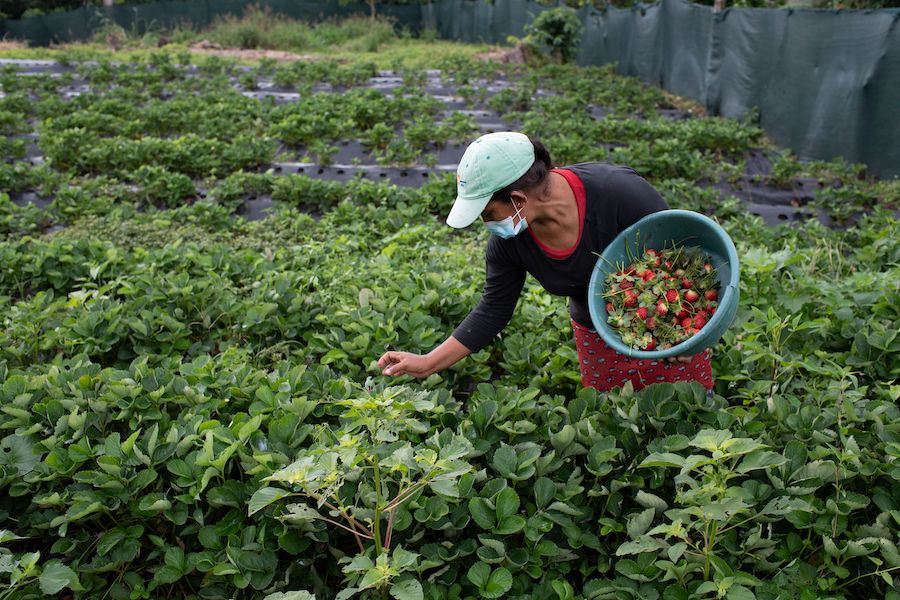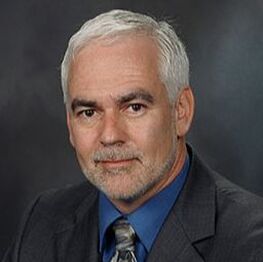A quarter of a million homes destroyed. Half a million residents homeless. More than 5 million seeking aid.
What sounds like a nightmare to most became a reality for those living in Guatemala, Honduras, and El Salvador, or what is otherwise known as the Northern Triangle.
On the day of the 2020 presidential election in the United States, Hurricane Eta made landfall in Nicaragua. With winds breaching 140 mph, the Category 4 hurricane ripped through Honduras and Guatemala, causing massive flooding, landslides, and power outages.

But before the damage could be fully measured, another disaster was on the way. Hurricane Iota barreled toward the region as the strongest storm in the Atlantic in over 100 years. Just 15 days after Eta, Iota made landfall in Nicaragua.
These storms were about as powerful as Hurricanes Katrina and Harvey that devastated New Orleans and Houston, respectively. The number of people needing assistance—over four million—is more than the population of Los Angeles, the third-largest city in North America.
These catastrophes struck a region already rife with violence, corruption, poverty, and increasing agricultural damage caused by a changing climate. Worse still, they hit amid the Covid-19 pandemic, which had decimated national and local economies. Eta and Iota were the tipping point for many people in the region who had already barely survived a multitude of hardships before the storms. After the hurricanes passed, mass migration ensued, mainly to the United States.
While countries in the region received some aid, it is only a short-term fix to long-term problems. Strategic measures must be taken to not only allow the Northern Triangle nations to become stable and autonomous, but also to prevent further migration from the region.
A Small Band-Aid on a Large Wound
After the two hurricanes struck, the world quickly responded by providing aid and disaster relief.
The United States has been the largest contributor of hurricane relief to the region, donating a total of around $48 million in aid since December from the U.S. Agency for International Development (USAID). Nearly all of those funds went to Honduras and Guatemala, while only a small fraction went outside of the Northern Triangle region to Nicaragua and Colombia.
The second-largest contributor has been the European Union, providing almost $22 million in aid. France also sent material relief items and supplies to Honduras and Guatemala through the EU Civil Protection Mechanism. At the same time, the European Union’s Copernicus satellite service provided maps to the affected countries to further EU assistance.
Additionally, Switzerland, South Korea, and Japan provided a total of $11.5 million in aid.
The International Federation of Red Cross and Red Crescent Societies (IFRC) also supported evacuation efforts, rescued those trapped by floods, and provided emergency first aid and psychosocial support. The American Red Cross sent the organization half a million dollars for additional help.
While the relief efforts were significant, they remain insufficient. The hurricanes caused nearly $9 billion in damages, far exceeding the $82 million provided. UNICEF has only received about a third of the nearly $43 million it has requested. The amount sent by the United States pales in comparison to the nearly $1 billion provided after Hurricane Mitch over two decades ago (which generated far less damage). The Biden administration recently announced that $4 billion will be sent to the region, but most of that will go to other initiatives.
Although the assistance provided has mitigated some of the damage, the region is still far from a full recovery.
The Final Straw
I would look at the underlying situation right now and say it’s pretty bad. We’ve got democratic backsliding, authoritarianism, high levels of gang and narco violence. You haven’t seen a ton of sustained success in the economic development programs.
Jacob Kurtzer
The region was already experiencing mass migrations because of widespread unemployment, food insecurity, gender-based violence, climate change, and organized crime. In recent years, about 300,000 residents in Honduras, Guatemala, and El Salvador have continued to leave annually.
According to Catalina Varga, CARE’s regional humanitarian manager for Latin America and the Caribbean, “The impact of the hurricane season aggravated the situation of poverty, hunger, and inequality that is occurring in both Guatemala and Honduras due to the Covid-19 pandemic. It has created the conditions for thousands of people to migrate in search of a better life, exposing women and girls to gender-based violence and human trafficking along migratory routes.”
In October 2018, several hundred residents from Honduras began their journey north from the city of San Pedro Sula toward the United States. By the time they reached the border, the group numbered in the thousands, becoming the controversial “migrant caravan” that was highlighted during that year’s U.S. midterm elections.
The ongoing humanitarian crisis in the aftermath of Eta and Iota are contributing to similar mass migrations today. “The people who make up the ‘migrant caravans’ come from the areas most affected by the storms,” Varga stated.
The disasters were especially devastating for a region that had already seen a dramatic economic downturn from the pandemic. All three Northern Triangle nations saw a drastic fall in exported goods in the spring of 2020. According to the International Monetary Fund, El Salvador was affected the most, with a 60 percent decrease in exports.
Massive unemployment—especially among the large number of agricultural workers in the region—also contributed to a surge in migration. The region has also experienced crop losses due to climate change. This is especially the case in the Dry Corridor, an area of drying farmland that stretches across the Northern Triangle. The corridor was significantly affected by poor rainfall during growing seasons in 2018 and 2019. These dry seasons created a dramatic increase in food prices and scarcity.
Just as agricultural conditions began to improve in October 2020, entire crops were erased by Eta and Iota a month later. The government of Nicaragua estimated that the disasters destroyed 80 percent of the country’s agricultural sector.
Agricultural problems are not the only issues driving out residents. Violence has also long plagued the region, with homicides rising rapidly since the 2000s. Sexual and gender-based violence is also widespread. Criminal organizations seek drug trafficking routes through the region, increasingly conflicting with one another and law enforcement. This has led to increased intimidation, bribery, and government infiltration. Gangs such as the 18th Street Gang (M-18) and the Mara Salvatrucha (MS-13) often engage in turf wars to control drug distribution, extortion, and other illegal activities.
While the pandemic and government lockdowns initially disrupted criminal and gang activities, reports suggest domestic violence, gang activity, and illegal trafficking groups quickly adapted.
“There is, of course, a surge at the border,” says Haugaard. “There is all this bottled-up demand for asylum and for access to migration [due to] the last two hurricanes. And so, of course there are going to be more people coming across the border. But we have to look at this in a long-term way and focus on the long-term impact, which means you really have to try to address the root causes of why people are fleeing.”
Corruption Amid Chaos
There is also a concern that aid sent to the region to address these problems will fall into the hands of corrupt governments. Political corruption and weak governance are some of the most persistent problems facing the three nations. Guatemala, Honduras, and El Salvador were all recently ranked lower than 103 out of 180 countries worldwide in corruption by Transparency International.
Natural disasters provide corrupt governments the opportunity to disperse aid to a vulnerable population in the interests of boosting favoritism to their political party or organization. Internationally, countries may be wary to provide relief aid and funding directly to governments because of issues of accounting where funds are going. As Ralph Merriam, Regional Representative Northern Triangle for Corus International-Lutheran World Relief, explains there is an issue of accountability in regard to funding long-term programs with ever-changing climates. Humanitarian aid is incapable of solving these internal issues since the practice of government corruption is embedded within multiple government agencies.
Natural disasters such as Eta and Iota can provide corrupt governments the opportunity to distribute aid resources to favored groups or in ways that serve their own interests rather than the public good.
Foreign donors could be hesitant to provide aid directly to governments because of accountability issues regarding the use of funds. Ralph Merriam, the Northern Triangle regional representative for Corus International-Lutheran World Relief explains there is an issue of accountability, as it may be difficult to monitor long-term funding for more permanent solutions with ever-changing conditions.
Efforts to quell corruption have been met with resistance by the three nations. International anti-corruption missions have been replaced with government-sponsored ones that lack legitimacy. Journalists and media who expose organized crime and corruption are often targeted.
Approximately 94 journalists have been murdered in the region since 2000, discouraging further investigations. Honduras, the nation hit hardest by the hurricanes, ranks the worst of the three in a World Press Freedom Index, at 136 out of 180.
Importance of Localization

Providing financial support to communities through local organizations is a good strategy to create resilient mechanisms to combat climate change, institutional issues, and support democratic governance. The people in these communities have the best understanding of the issues they face and where funds are needed most.
However, the Biden administration’s objective to aid the Northern Triangle through a four-year, $4 billion regional strategy predominantly depends on the private sector. This means the aid could potentially be inaccessible to local communities since the method of distribution may require a top-down approach where individuals making decisions about funding are disconnected from the community.
When international organizations take such a top-down approach, money can easily be lost and local organizations may receive smaller grant amounts than intended. Haugaard has noted the possibility of U.S. contractors absorbing a majority of aid funding, since for-profit contracting agencies disperse “the smaller grants sometimes to local civil society groups,” although the support is still beneficial to ongoing projects. Non-profit organizations, on the other hand, may be more capable of maximizing the funding that is given to them.
Large dollar investments are not enough, as they establish a dynamic of dependency on external resources. As Merriam mentions “to break the cycle of dependency, [organizations] would have to be more self-funded. As long as that funding is coming from outside, they will be dependent.” Investments in local organizations provide assurance of where disaster aid is being distributed and allows these communities to make decisions about their future.
Providing aid directly to communities and organizations is an effective way to mitigate corruption and migration. As Haugaard suggests, aid is most effective when “working with small farmers and cooperatives, and smaller organizations in cities as well, to carry out local community-driven programs,” since the investment will be more precisely targeted.The process of finding effective local partners must involve collaboration with individuals who are already doing work on the ground.
When partnering with local organizations, Jacob Kurtzer, director of the Humanitarian Agenda at CSIS, mentions that donors can mitigate risks by avoiding known corrupt entities and implementing greater oversight over how funding is used. However, donors should also be willing to accept that some funds may be misdirected or lost in the process, and focus on maximizing the impact of aid instead of imposing excessive oversight.
Creating a Resilient Future
We actually know how to create resilience to climate change; we know what hurricane or earthquake resistant construction looks like.
Erol Yayboke
Aid is only a temporary solution, so donors must consider long-term approaches of resiliency and development. Donors may be reluctant to invest in long-term solutions when there are short-term problems that require immediate attention and are still critical for the futures of these communities.
Infrastructure is key for disaster preparedness, particularly because climate change is leading to more intense weather events and less predictability. Investing in disaster risk management frameworks can be an approach that already uses existing buildings and localizes the process of urban and rural planning. The Global Facility for Disaster Reduction and Recovery mentions how communities can be better prepared if there is an understanding at a local level of government about disaster risk management law to reform these policies to combat unique circumstances.
Organizations such as Lutheran World Relief (LWR) provide direct support to communities in Guatemala and Honduras by establishing programs on developing agriculture, combating climate change, and increasing economic prospects. One LWR program works with young women, typically daughters of coffee farmers, to teach them an array of skills, including how to improve farm productivity and crop quality, how to conduct maintenance, and how to repair the metal infrastructure necessary for coffee production. This program creates economic opportunities and community resilience by empowering young women.
Allocating disaster relief funds to the agricultural sector can also build resilience. Funding in the aftermath of such destructive storms is critical for enabling local solutions, most importantly to protect agricultural assets. Investing in sustainable agriculture can create improved responses for any major climate shocks in the future.
In addition to supporting sustainable practices, Indigenous communities demonstrate the value of such practices for climate resiliency in practice. This makes listening to such communities a priority when investing in sustainable agriculture. A study of global agricultural techniques found that “[traditional] farming systems are repositories of a wealth of principles and measures that can help modern agricultural systems become more resilient to climatic extremes.” Techniques such as “crop diversification, maintaining local genetic diversity, animal integration, soil organic management, water conservation, and harvesting” all have shown promise in helping farmers adapt to changing climates.















